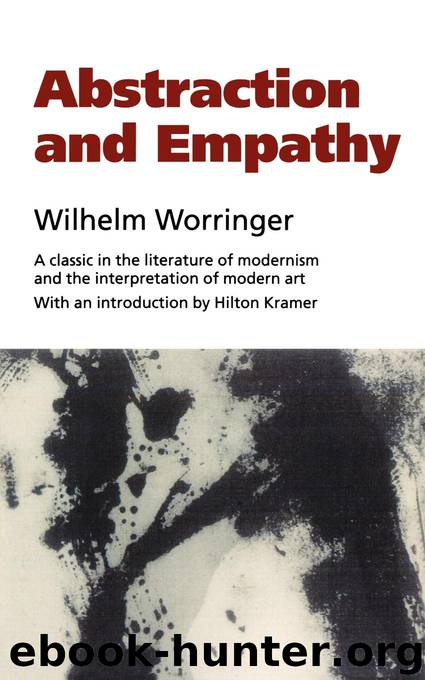Abstraction and Empathy by Wilhelm Worringer

Author:Wilhelm Worringer
Language: eng
Format: epub
Publisher: Rowman & Littlefield Publishers
Published: 1997-02-25T16:00:00+00:00
* Translator’s Note.—Here and throughout the book ‘regularity’ translates the German word Gesetzmässigkeit; but it is equally the normal translation of Regelmässigkeit, which is here contrasted with Gesetzmässigkeit. For the sake of this contrast ‘uniformity’ is used here to translate Regelmässigkeit, a makeshift solution which indicates the difficulty of sustaining the verbal distinction in English.
CHAPTER FOUR
Selected examples from Architecture and Sculpture from the viewpoints of Abstraction and Empathy
THIS chapter aims, without making any claim to completeness, to sketch the major lines which lead from the Antique to the post-Christian era, in order, in the final chapter, to analyse under these premises the so differentiated artistic volition of the Middle Ages.
In the foregoing chapter we defined Greek ornament as a thoroughly felicitous balance between abstract and naturalistic tendencies with a strongly marked preponderance of the latter. Since we see in the absolute artistic volition of a people the direct fruit of its psychic disposition, we can in principle extend a definition that we have read off from the paradigm of ornament without more ado to all the other branches of art. Or, more accurately, we shall find our definition of the artistic volition, arrived at by an analysis of ornament, corroborated by the other types of art.
The disposition to abstraction which, with the Greeks as with all other peoples, stands at the commencement of the practice of art, was so rapidly pushed into second place amongst this people of joyful temperament by delight in the organic, which finally drowned it entirely, that we may confine our investigation to demonstrating what powerful expression the abstract principle nonetheless found, particularly at the beginning of the epoch. Indeed, because the prevalence of the naturalistic organic principle is so striking, it seems to us a great deal more interesting to search out the traces of an abstract tendency, which are nevertheless present. Archaic Greek art was still clearly in the grip of abstract tendencies, and it would require an intensive investigation to analyse the processes by which, in relatively so short a time, the endowment of the Greeks with its devotion to the organic worked itself free of these abstract fetters and within a century hastened to the goal of its authentic artistic volition, a movement that proceeds almost synchronously in architecture, sculpture, and vase-painting.
An example from architecture may elucidate the situation. A comparison between the Doric and the Ionic temple will at once show the way in which the abstract principle was displaced by the organic. The Doric temple represents the product of an artistic volition still directed towards the abstract. Its inner constitution, if we may call it that, is still based on a purely geometric, or rather stereometric, inexpressive regularity, beyond whose clearly described boundaries it has no wish to go. The laws of its construction are still none other than the laws of matter. This abstract inner constitution gives it that earnest heaviness, that compactness, lifelessness, that immutable subjection to the spell of matter, which go to make up its unparalleled Solemnity.
Download
This site does not store any files on its server. We only index and link to content provided by other sites. Please contact the content providers to delete copyright contents if any and email us, we'll remove relevant links or contents immediately.
Ways of Seeing by John Berger(1293)
The Perfumes The A-Z Guide by Luca Turin(1099)
Rembrandt Drawings by Rembrandt(1088)
The Hare with Amber Eyes by Edmund de Waal(1077)
It's Never Too Late to Begin Again by Julia Cameron(981)
On Photography by Walter Benjamin(928)
Natasha's Dance by Orlando Figes(897)
A Month in Siena by Hisham Matar(866)
Why Architecture Matters by Paul Goldberger(826)
Minor Feelings by Cathy Park Hong(817)
The Sound of Paper by Julia Cameron(815)
0062259628 by Sarah Strohmeyer(815)
The Selected Poetry of Rainer Maria Rilke by Rainer Maria Rilke(815)
0544325265 by Brendan Jones(800)
Citizen: An American Lyric by Claudia Rankine(782)
Proust Was a Neuroscientist by Jonah Lehrer(768)
The Death of the Artist by William Deresiewicz(753)
Perfumes the Guide 2018 by Luca Turin(752)
And Our Faces, My Heart, Brief As Photos by John Berger(725)
